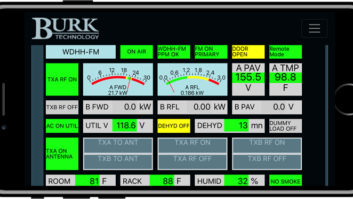
The author is senior engineer with Cavell Mertz & Associates Inc.
Audio processing has reached a level of performance where audio content can have high loudness without the traditional artifacts of audible clipping, pumping, intermodulation distortion, etc.
Of course, audio processing in a broadcast medium is justifiable for over-modulation protection and combatting noisy listening environments.
Due to freedom from distortion in processors and loudness wars, however, much of radio has reached a state of hyper-compression, where already-compressed popular music is fed to multiband compressors and limiters that aggressively reprocess the audio.
This situation is hard to reverse in broadcast, where competitive loudness remains a concern, but I believe minimal processing may be the right direction for online radio media.
I hate to be nostalgic, but FM was once considered a “high fidelity” medium (I’m old enough to remember!).
Consumers used to buy exquisite, expensive tuners to get the best FM sound for their living room systems. Today a number of my non-technical friends don’t even hook up the antenna on their multimedia receivers.
What happened to that reputation, and is it connected to FM’s gradual loss of listeners to online media?
A look at the General Electric transmitter two-page ad in a 1940s issue of Broadcasting Magazine says a lot about FM’s change. (You can see it in detail by clicking the image.)

The signal-to-noise ratio of the new FM system promised to deliver “double the Dynamic Range” of AM and remove “the unreality of artificially controlled sound levels that compress a fortissimo.”
Using an ingenious size comparison between AM and FM (using a photo of an all-woman orchestra during World War II) GE touted the “contrasts of sound intensities … in all its glorious realism.”
Along the way, years ago, FM radio got the idea that dynamic range had no value, and louder was better.
The development of stronger and stronger FM audio processors began. That seemed to work for FM for many years — after all, it was a portable and in-car medium with lower noise and wider frequency response than AM, as well as stereo.
However, the 2000s brought a newer medium: online digital audio that could be delivered to smart phones as well as home computers.
Is less more?
While FM’s decline of listeners may be due to a combination of causes, online audio (streams, podcasts and on-demand playout) have flourished.
Online audio is a 16-bit digital system having a dynamic range greater than 90 decibels, regardless of the bit rate, and lossy compression codecs have continued to improve in sound quality.
Younger listeners play music and shows online and from digital personal collections. My research finds that this music is distributed almost entirely in its original, unprocessed form.
This is true of major on-demand music services, and some are now are offering high-fidelity channels with higher bit rates and even “lossless” coding. The tracks are simply normalized (gain offset) to a common loudness target, without touching the dynamic range of the content.
In a recent project for a major radio group, I found that some online distributors of live station audio are using substantially less processing than their on-air broadcasts. Perhaps some are learning that “artificially controlled sound levels” are not preferred by listeners.
Similarly, podcasts — the fastest growing segment of online audio — are produced and delivered with little or no audio processing.
The target loudness of the online industry is changing to a lower value to permit greater dynamic range.
Rethinking the target
I have the privilege of chairing a drafting committee at the Audio Engineering Society, which is writing a new technical document for online audio parameters.
These interim specifications will evolve to a profile with even wider dynamic range to match audio-for-video standards — and we know how much dynamic range video services deliver!
Broadcasters are now faced with another choice if they adopt “hybrid radio,” which provides a streaming alternative to radio reception as listeners drive outside the broadcast coverage.
FM stations could choose to match the audio processing of their stream to the (hyper-compressed) broadcast audio, to avoid changes as the dashboard receiver switches between off-air and stream.
Or should they? Perhaps radio should reconsider what it broadcasts and move with the audio industry and away from heavy compression.
When hyper-compressed audio is normalized to the same integrated loudness as lightly-processed audio, a heavily-compressed stream sounds weak and flat by comparison. Compressing a stream to sound like air can’t compete with natural, dynamic sound.
Considering this, wouldn’t it be wonderful if the FM stations, too, returned their own air audio to a high-fidelity condition, as FM promised 75 years ago?
A free Radio World ebook explores trends in processing for radio, including the management of over-the-air and streamed signals. Find it at radioworld.com/ebooks.





